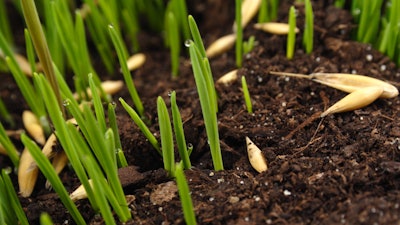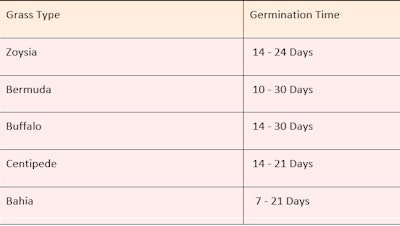
Starting a new lawn from seed can be an uphill battle, especially if you’re customers are in a hurry to out-grass their neighbors with a lush, green carpet of turf. Let’s face it: a watched lawn takes forever to grow.
Most grass seed takes at least two weeks to germinate, but it all depends on the type of grass you plant and the climate where you’re planting it.
Grasses are generally divided into warm- and cool-season species. Cool-season grasses are generally grown in areas where freezing temperatures are normal through the winter months, while the warm-season grasses flourish in regions with more mild to hot temperatures.
Warm-Season Grasses
In most cases, warm-season grasses take a bit longer to germinate and can turn brown and die in temperatures lower than 50 degrees. Most are drought-resistant and can handle a large amount of sun. Some can't handle the shade and will die when planted under trees. The best time to plant warm-season grasses is early spring to early and late summer.

Warm-season grasses grow best when the daytime air temperatures are between 80 to 95 degrees, and the soil temperature is above 65.
- Zoysia: This low-maintenance, drought-resistant grass takes 14 to 24 days to germinate. Zoysia grass is low growing and can handle foot traffic and a lower cut.
- Bermuda grass: A salt and drought-tolerant grass that is one of the more commonly used warm-season grasses, Bermuda grasses can germinate in as little as ten days but can take up to 30 days to establish itself. Most Bermuda grasses have poor to moderate cold tolerance but good heat tolerance.
- Buffalo grass: One of few U.S. native grasses, buffalo grass can take 14 days to germinate and produce a beautiful turf in about a month. It’s also low-maintenance and doesn’t need mowing as often as other warm-season grasses, providing a turf-style medium density.
- Centipede - New seed will germinate in 14 to 21 days. This turf can handle more shade than Berumuda or Zoysia grass but grows better in the sun and heat. Due to a slower growth rate, it’s recuperative ability to high traffic is reduced.
- Bahia - Extremely drought and heat-tolerant, bahia grass requires little water or maintenance. New Bahia grass seeds germinate quickly - between 7 and 21 days. This grass is excellent for homes along the gulf coast and requires little fertilization.
Cool-Season Grasses
Cool-season grass grows much faster and should be planted between late August to early September, although some can be started in late spring.
They are less drought resistant and heat tolerant than warm-season grasses and require more water. These grasses can also stay green until the daytime temperature dips below freezing.

For cool-season grasses, the daytime air temperature should be between 60 to 75 degrees, but you can plant them until the soil temperature hits 55 degrees.
Avoid planting when there’s a threat of frost in your area. Wait at least 90 days before planting after a frost in colder climates and 60 days after the last frost in warmer areas.
- Bentgrass - This type of grass can germinate in as little as a week, but it’s not recommended for residential lawns because it is considered a high maintenance grass, being more susceptible to a wide range of diseases. It can be found on golf courses, lawn tennis courts, and bowling greens.
- Kentucky Bluegrass: Among the most popular cool season grasses that creates a lush, dense lawn in as little as 21 days. It has a high tolerance to cold and good recovery potential, while not the best in high foot traffic areas.
- Tall Fescue: One of the most adaptable grass types, tall fescue grasses germinated very quickly, between 5 to 13 days. Fescue grass’ recuperative potential is low, however, due to the extensive root system it is labeled as drought and pest resistant.
- Red Fescue: Red fescue grasses typically do well in shade and do well in lawns with heavy foot traffic. The seeds take between 12 to 23 days to germinate.
- Perennial Ryegrass: Similar with red fescue, ryegrasses are often mixed with a bluegrass with foot traffic tolerance and quick germination as a result. Another fast grower, perennial ryegrass can germinate in 5 to 10 days and comes back year after year as strong as ever. It’s extremely cold tolerant and also endures heat and drought.
- Annual Ryegrass - Annual ryegrass also has a germination time of 5 - 10 days but is not as durable as its perennial counterpart. It is best to mix it with other grass types when overseeding to give new life to a dying lawn.
In the dirt
You can’t force a seed to take to a soil it doesn’t like. Dirt varies in alkalinity, nutrients, temperature, and because each grass type is particular, the type you want may not grow in your soil. Testing your customers’ soil beforehand can help you choose the right seed for their yard.
Prepping a lawn before planting grass seed can help speed up the germination process and reduce the work you’ll have later.
- Remove weeds. You can do this either manually or with a chemical weed killer. If you decide to go the chemical route, check the package to see how long you must wait before planting in that area.
- Have a seedbed ready. That means removing any rocks, debris, or exposed tree roots. Once the space is cleared, you can carve out a level, slightly concave area for your seedbed.
- Once you’ve set up your seedbed, evenly spread an inch of compost or other fertilizer over the top and water it down to 6-8 inches.
- Plant your seeds and inform the customers to water them regularly with a light spray. The area should be damp with water but not so much that puddles form.
Watering is a balancing act and keeping the soil moist as the grass seeds germinate is crucial. Overwatering can cause the seeds to rot or wash away and underwatering can prevent the grass from growing. After planting your seeds, you should water them regularly so that the top two inches of the soil are damp but not soaked through. The time of day you water can affect the growth as well. You should water in the morning to avoid too much evaporation from the midday sun, and if the grass is sprouting, you should water up to just an inch. Avoid watering at night as the stagnant water invites fungus growth.
- Avoid any foot traffic as the seeds grow, and you can mow the area once the grass has reached a height of 2 - 3 inches.
Through years of modification, we’ve been able to turn grass into one of the most show-stopping parts of any home’s exterior. A new green lawn that's lush and cared for can boost curb appeal and make staying at home that much better for your customers.



















